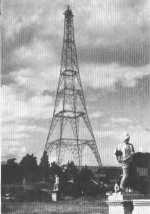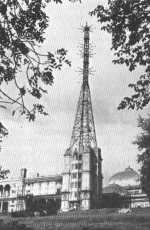Home > Snippets > Hail and
Farewell
Whirligig Snippets
Hail and Farewell
The BBC opens its new London transmitting
station
The BBC's new TV transmitting station at the
Crystal Palace site, in South London in 1956, replaced the
original transmitting station at Alexandra Palace with which the
BBC service opened in 1936. Alexandra Palace was the first
high-definition TV station in the world. Little was known in 1936
about the range of a high-power transmitter working on a
frequency of 45 Mc/s, and it was thought that the range for
satisfactory reception would not exceed thirty miles. The site of
the first station was therefore chosen so that the maximum number
of viewers would be included within that range.
 In fact, the range of thirty miles
was considerably exceeded. Moreover, technical developments made
it possible to use transmitters of considerably higher power and
a range of at least fifty miles became possible. This factor, and
the density of population in the area to be covered, indicated
that the maximum number of people would be covered by moving the
station to a site south of the Thames. The site at Crystal Palace
was chosen after consideration of a number of alternatives.
In fact, the range of thirty miles
was considerably exceeded. Moreover, technical developments made
it possible to use transmitters of considerably higher power and
a range of at least fifty miles became possible. This factor, and
the density of population in the area to be covered, indicated
that the maximum number of people would be covered by moving the
station to a site south of the Thames. The site at Crystal Palace
was chosen after consideration of a number of alternatives.
The station building was underground in
order to comply with the requirements of the London County
Council (who owned the Crystal Palace grounds) that public access
to this area should not be impeded. The building was planned so
that it would be possible to extend it in the future to house
further equipment which might be needed, for example, for
transmissions in Bands IV and V or for the development of colour
television.
The Crystal Palace was believed to be one of
the most efficient TV stations in the world. In planning the
actual transmitting installation, great emphasis was placed on
reliability. The vision transmitter consisted of two identical
units each producing a peak-white power of 15 kW, and the sound
transmitter of two identical units each producing an unmodulated
carrier power of 4 kW.
Each transmitter had its own programme-input
equipment for vision or sound as the case may be, and the
inclusion of common lines in the chain from the programme input
to the aerial was avoided wherever possible. Where this was not
possible, the equipment was duplicated and provision made for an
immediate change-over if a fault should develop. This arrangement
permitted an important saving in staff costs because if a fault
should develop in a particular piece of equipment, the service
was not interrupted. Immediate attention to faults was,
therefore, not vital and this enabled the staff on watch to be
reduced to two men.
 The transmitting
aerials were carried on a self-supporting tower which is tapered
to a height of 440 feet above ground level, and then continued as
a parallel-sided structure for a further 250 feet. The aerial
system consisted of eight tiers of dipoles mounted partly on the
support tower and partly on the parallel-sided portion above it.
The tapered section of the uncompleted tower is shown in the
photograph above.
The transmitting
aerials were carried on a self-supporting tower which is tapered
to a height of 440 feet above ground level, and then continued as
a parallel-sided structure for a further 250 feet. The aerial
system consisted of eight tiers of dipoles mounted partly on the
support tower and partly on the parallel-sided portion above it.
The tapered section of the uncompleted tower is shown in the
photograph above.
The aerial system was divided electrically
into two halves, one vision and one sound transmitter feeding
power to one half of the system, while the duplicate vision and
sound transmitters fed power to the other half via a separate
feeder and combining unit.
Power-supply equipment had already been
installed to take account of possible future requirements. It had
sufficient capacity to handle the load imposed by two 50 kW
vision transmitters and two 12 kW sound transmitters. Provision
had been made for additional transmitters of comparable power for
a second programme channel later.
Adapted from an article in: "The
Television Annual for 1957".
Return to Snippets Index

If
you have any comments or further information of interest, please
e-mail
snippets@whirligig-tv.co.uk
 In fact, the range of thirty miles
was considerably exceeded. Moreover, technical developments made
it possible to use transmitters of considerably higher power and
a range of at least fifty miles became possible. This factor, and
the density of population in the area to be covered, indicated
that the maximum number of people would be covered by moving the
station to a site south of the Thames. The site at Crystal Palace
was chosen after consideration of a number of alternatives.
In fact, the range of thirty miles
was considerably exceeded. Moreover, technical developments made
it possible to use transmitters of considerably higher power and
a range of at least fifty miles became possible. This factor, and
the density of population in the area to be covered, indicated
that the maximum number of people would be covered by moving the
station to a site south of the Thames. The site at Crystal Palace
was chosen after consideration of a number of alternatives. The transmitting
aerials were carried on a self-supporting tower which is tapered
to a height of 440 feet above ground level, and then continued as
a parallel-sided structure for a further 250 feet. The aerial
system consisted of eight tiers of dipoles mounted partly on the
support tower and partly on the parallel-sided portion above it.
The tapered section of the uncompleted tower is shown in the
photograph above.
The transmitting
aerials were carried on a self-supporting tower which is tapered
to a height of 440 feet above ground level, and then continued as
a parallel-sided structure for a further 250 feet. The aerial
system consisted of eight tiers of dipoles mounted partly on the
support tower and partly on the parallel-sided portion above it.
The tapered section of the uncompleted tower is shown in the
photograph above.